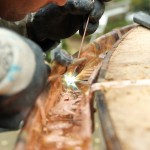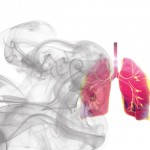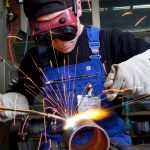How welding fumes and pollutants are created
If welding fumes are formed, a whole chain of physical and chemical processes is behind them. The pollutants in the welding fumes are also formed by very different elements during the welding process.
Welding fumes are created at the high temperatures produced by an arc or flame which contacts the material. During this process, physical and chemical processes such as evaporation, condensation, oxidation, thermal decomposition (thermal-chemical cleavage) or burning occur. This results in pollutants which can be formed from:
- additional materials
- base materials
- inert gases
- coatings
- impurities
- surrounding air
The pollutants are different depending on the process and the material. They are basically classified into particulate and gaseous. The following rule applies: in the case of particulate pollutants, the chemical composition of the material determines it within the pollutant. In contrast, the creation of gaseous pollutants is influenced by the process being applied.
Gases mainly occur as a reaction product of the gases and gas mixtures being used and occurring. Particulate substances are mainly formed from the welding additives and the coatings being used. The effect that hazardous substances have on the human organism depends on their concentration, size distribution and composition. One assessment scale for this purpose is the workplace limit values in accordance with e.g. the German TRGS 900 in addition to the explosion risk assessment yardsticks in accordance with TRGS 910. In addition, there is the welding fume emission rate: this states what volume of welding fumes are created over a specific period. Depending on the process, it is itself dependent on a variety of influencing variables.
Particulate pollutants
- Iron oxide: this arises from additives and basic materials during welding and the cutting of steel materials.
- Fluoride: this arises from the coating used on the rod electrodes or the filling in the cored wires if lime-based coatings or fluxes containing fluoride are used.
- Chrome (VI) compounds: these compounds arise during the use of high-alloy coated rod electrodes during manual arc welding. Furthermore, they are also formed during welding with high-alloy cored wires containing chrome. They are also formed during overlap welding of manufacturing coatings containing zinc-chrome (repair welding).
- Nickel oxide: these oxides are mainly formed during welding with pure nickel and nickel-based materials or during plasma cutting of high-alloy steels containing nickel out of the basic material.
- Thorium oxide: this pollutant is formed during TIG welding from the tungsten electrodes containing thorium oxide – especially in the case of aluminum materials.
Gaseous pollutants
- Carbon monoxide: this pollutant is mainly formed during metal active gas welding using carbon dioxide (MAGC) or metal active gas welding using mixed gases. The carbon dioxide is thermally decomposed during the process.
- Nitrogen dioxide: this is produced during various processes such as oxyacetylene welding and is formed by the oxidization of the atmospheric nitrogen at the edge of the flame or the arc.
- Ozone: this is formed from the oxygen in the air by ultraviolet radiation. This occurs particularly during inert gas welding of strongly radiation-reflective materials such as aluminum and aluminum silliciumalloys.
- Phosgene: this pollutant occurs if greasing agents containing chlorinated hydrocarbons are heated or subjected to UV radiation.
The concentration of all these pollutants in the air at the workplace must be determined through measurement. According to the Safety At Work Act (ArbSchG), the employer is obligated to take the necessary measures against these hazards. This means that the correct extraction devices have to be installed depending on the process, the material and the welding fumes caused by these factors.





